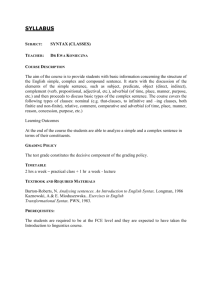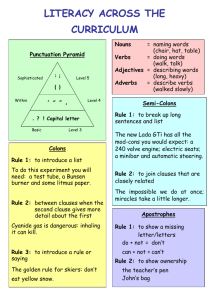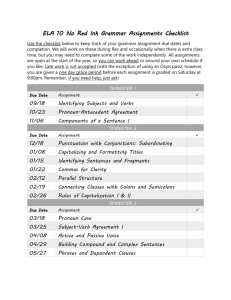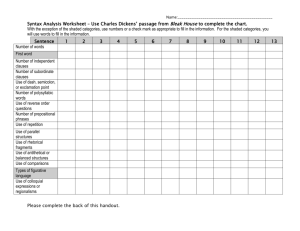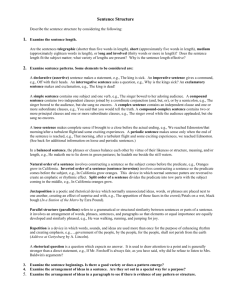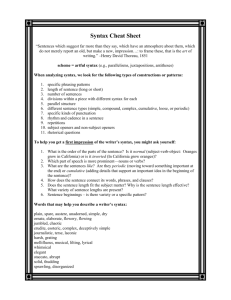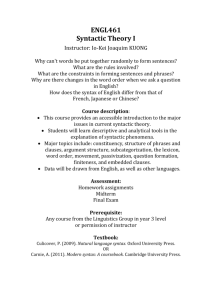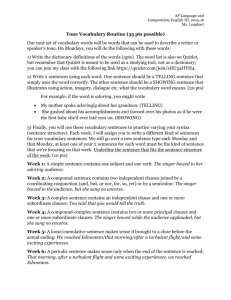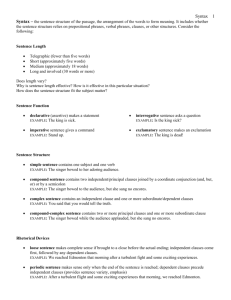Analyzing Syntax The Scarlet Letter
advertisement
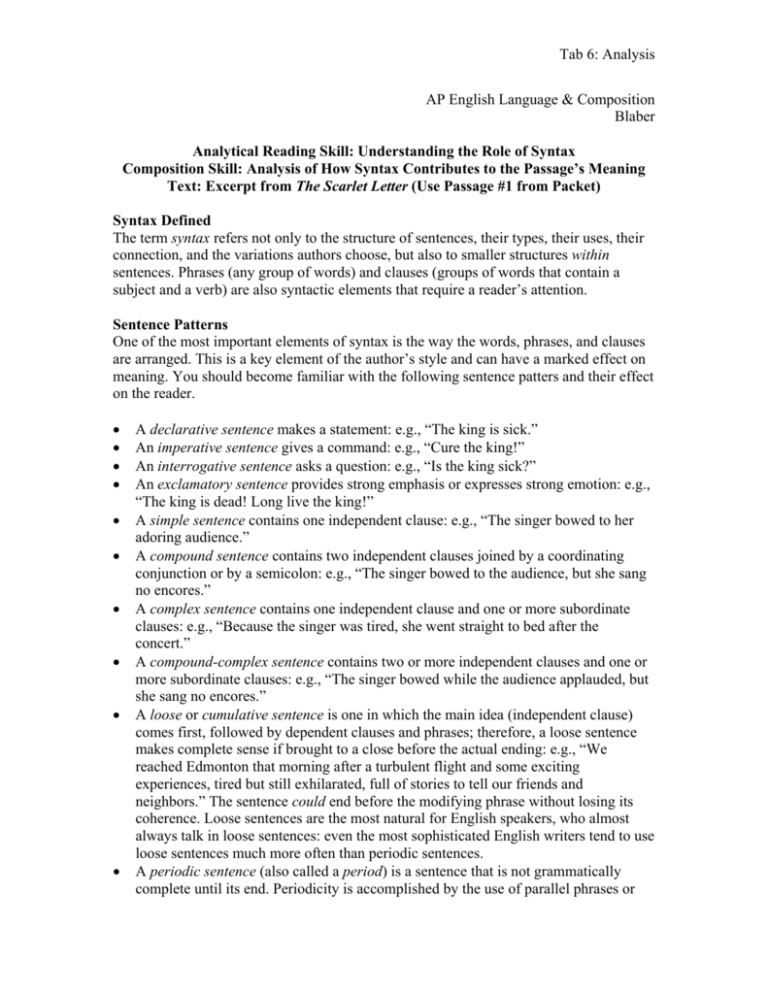
Tab 6: Analysis AP English Language & Composition Blaber Analytical Reading Skill: Understanding the Role of Syntax Composition Skill: Analysis of How Syntax Contributes to the Passage’s Meaning Text: Excerpt from The Scarlet Letter (Use Passage #1 from Packet) Syntax Defined The term syntax refers not only to the structure of sentences, their types, their uses, their connection, and the variations authors choose, but also to smaller structures within sentences. Phrases (any group of words) and clauses (groups of words that contain a subject and a verb) are also syntactic elements that require a reader’s attention. Sentence Patterns One of the most important elements of syntax is the way the words, phrases, and clauses are arranged. This is a key element of the author’s style and can have a marked effect on meaning. You should become familiar with the following sentence patters and their effect on the reader. • • • • • • • • • • A declarative sentence makes a statement: e.g., “The king is sick.” An imperative sentence gives a command: e.g., “Cure the king!” An interrogative sentence asks a question: e.g., “Is the king sick?” An exclamatory sentence provides strong emphasis or expresses strong emotion: e.g., “The king is dead! Long live the king!” A simple sentence contains one independent clause: e.g., “The singer bowed to her adoring audience.” A compound sentence contains two independent clauses joined by a coordinating conjunction or by a semicolon: e.g., “The singer bowed to the audience, but she sang no encores.” A complex sentence contains one independent clause and one or more subordinate clauses: e.g., “Because the singer was tired, she went straight to bed after the concert.” A compound-complex sentence contains two or more independent clauses and one or more subordinate clauses: e.g., “The singer bowed while the audience applauded, but she sang no encores.” A loose or cumulative sentence is one in which the main idea (independent clause) comes first, followed by dependent clauses and phrases; therefore, a loose sentence makes complete sense if brought to a close before the actual ending: e.g., “We reached Edmonton that morning after a turbulent flight and some exciting experiences, tired but still exhilarated, full of stories to tell our friends and neighbors.” The sentence could end before the modifying phrase without losing its coherence. Loose sentences are the most natural for English speakers, who almost always talk in loose sentences: even the most sophisticated English writers tend to use loose sentences much more often than periodic sentences. A periodic sentence (also called a period) is a sentence that is not grammatically complete until its end. Periodicity is accomplished by the use of parallel phrases or Tab 6: Analysis • • • clauses at the opening or by the use of dependent clauses preceding the independent clause; that is, the kernel of thought contained in the subject/verb group appears at the end of a succession of modifiers: e.g., “That morning, after a turbulent flight and some exciting experiences, we finally reached Edmonton.” The periodic sentence has become much rarer in formal English writing over the past hundred years, and it has never been common in informal spoken English (outside of bad political speeches). My own biased opinion is that this is a result of our fast-food approach to contemporary life and all aspects of culture, including both non-fiction and literature. In fact, I think this is regrettable, because periodicity is a powerful rhetorical tool. An occasional periodic sentence is not only dramatic but persuasive: even if the readers do not agree with your conclusion, they will read your evidence first with open minds. If you use a loose sentence with hostile readers, the readers will probably close their minds before considering any of your evidence.Therefore, when it is used to arouse interest and curiosity, and to hold an idea in suspense before its final revelation, a periodic sentence is most effective. (Did you notice I used one there?) In a balanced sentence, the phrases or clauses balance each other by virtue of their likeness of structure, meaning, or length: e.g., “He maketh me lie down in green pastures; he leadeth me beside still waters.” Natural order of a sentence involves constructing a sentence so the subject comes before the predicate: e.g., “Oranges grow in California.” Inverted order of a sentence involved constructing a sentence so the predicate comes before the subject: e.g., “In California grow the oranges.” Other syntactical elements which we have studied separately include: juxtaposition, parallel structure, repetition, rhetorical questions and rhetorical fragments, anaphora, and antimetabole. Reading Selection by Nathaniel Hawthorne The prose of earlier centuries tends to be syntactically more complex than contemporary writing. Hawthorne’s writing in The Scarlet Letter typifies this style—ornate description, elevated language, frequent use of periodic sentence, and sentences in which several parts combine to describe the subject or clarify the major action of the verb. Consider the first sentence of passage #1 from your packet: The door of the jail being flung open from within there appeared, in the first place, like a black shadow emerging into the sunshine, the grim and grisly presence of the town-beadle, with a sword by his side, and his staff of office in his hand. Note first the inverted sentence structure. The subject is “the grim and grisly presence of the town-beadle,” and the verb “appeared” precedes it. The word “there,” which seems like the grammatical subject, is actually only a place holder, since it doesn’t tell us what appeared. Consider the effect of this order. Note the reader is first introduced to the door being flung open, then the tone-laden simile of a shadow emerging into sunshine, then the “grim and grisly presence of the town-beadle,” and finally his sword Tab 6: Analysis and staff. The inverted syntax presents the visual details in the exact sequence Hawthorne wants the reader to imagine. Within the sentence, in other words, the simile foreshadows the town-beadle’s impression on the crowd. Likewise, the tone established by the townbeadle’s “grim and grisly presence” anticipates and sets the mood for the character who follows him (both in the order of the passage and literally through the jail-house door)— the shame-faced Hester Prynne. Read the entire passage, paying close attention to the sentence structure. Then, write several paragraphs analyzing how Hawthorne’s syntax contributes to the meaning of the passage. Don’t summarize the passage and be sure to include blended quotes to illustrate your points.
